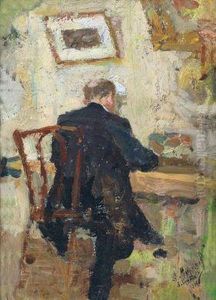Alexej Fedotowitsch Maximoff Paintings
Alexej Fedotowitsch Maximoff, also known as Alexei Maximovich Maximov, was a Russian artist born on May 7, 1886, in the town of Tula, located within the Russian Empire. Not to be confused with the anarchist writer Alexei Maximovich Peshkov, who is better known by his pen name, Maxim Gorky, Maximoff was a painter whose work was influenced by the changes and turmoils of early 20th-century Russia.
Maximoff began his artistic education at the Moscow School of Painting, Sculpture and Architecture, where he was under the tutelage of esteemed artists such as Abram Arkhipov and Konstantin Korovin. His early work showed promise, and he was considered part of the new generation of Russian artists who were seeking to break free from the academic traditions of the 19th century, embracing more modern and impressionistic techniques.
During his career, Maximoff participated in several exhibitions and was associated with art movements that contributed to the Russian avant-garde. His style evolved from impressionistic landscapes and genre scenes to more expressionistic works, reflecting the social and political upheavals of his time. The Russian Revolution of 1917 and the subsequent civil war had a profound impact on artists, and Maximoff was no exception. His work from this period reflects the tension and dynamism of the era.
In the aftermath of the October Revolution, many artists faced uncertain futures. While some embraced the new Soviet regime and its call for art to serve the state, others found themselves at odds with the restrictive policies concerning artistic expression. It is unclear how Maximoff navigated these challenges, as historical records of many artists from this period are incomplete or lost.
Alexej Fedotowitsch Maximoff's life was cut short at the age of 39. He passed away on April 24, 1925, in Paris, France. The circumstances of his death are not widely documented, which is not uncommon for artists of this period, many of whom experienced turbulent lives due to the political and social chaos of the era. Despite his early death, Maximoff left behind a body of work that contributes to our understanding of the Russian artistic landscape during a time of great change. His paintings are held in private collections and may be found in Russian museums, where they continue to be studied and appreciated for their historical and aesthetic value.
